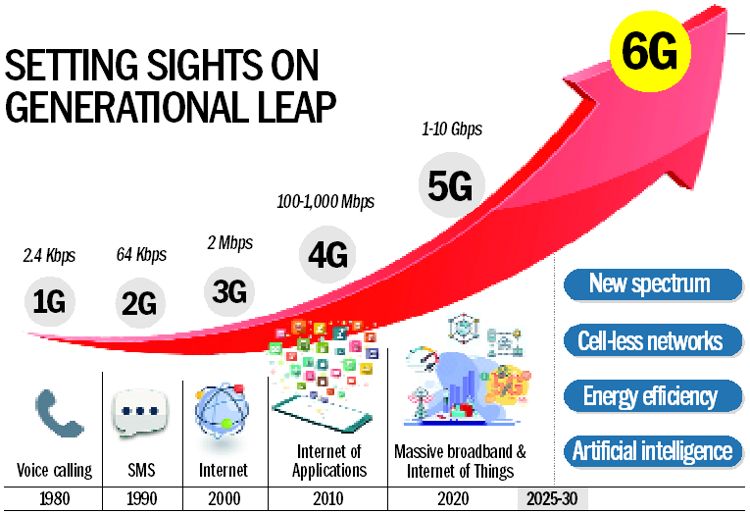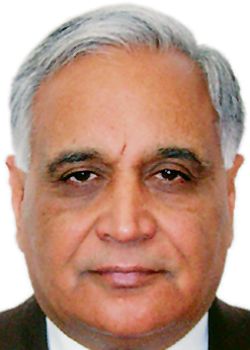
Courtesy: Towards 6g use cases, Networks and Technologies by Marco Giordani, Michele Polese, Marco Mezzavilla, Sundeep Rangan and Michele Zorzi in www.arxiv.org
Lt Gen Shamsher Singh Mehta (retd)
Former Western Army Commander & founder member of Pune International Centre
The Prime Minister’s clarion call on Atmanirbharta has been interpreted in many ways. One obvious direction is 6G. It is time to step out of the followers’ and adopters’ mindset. 2G, 3G, 4G... 5G.
It is now time to lead: As with any strategic endeavour on a national scale, 6G will first have to find support among the political leadership and the technology champions in India. We have had space and nuclear programmes that have displayed our skill and resolve. Our next mission around 6G will have to move to a different level with full and enduring support. India cannot become Atmanirbhar by neglecting its intellectual capital. India has to invest in diverse fields. Telecom is the leading candidate. It is the super-charger for a digital and multi-trillion dollar economy.
The landscape for R&D in the telecom sector would demand incentivising locally developed technologies, nurturing innovation by start-ups, and developing and deploying technological capability in the digitisation of India. Enabling this will also require getting our youth to pursue education and research careers that will make the 6G mission successful. India’s fortunes to reap the possibilities to transform into a developed digitised economy may be resting on success in harnessing 6G. This is a strategic area with an all-encompassing impact on the economy, technology and national security. More devices (not just phones), in fact every machine, vehicle and human connected with 1,000 times more bandwidth than 5G and applications which were constrained by 4G and 5G will become capable of delivering services of every kind to consumer and business, big and small, thereby generating more wealth and wellbeing for all. Our track record of adopting, following, and catching up with the rest of the world and then scaling up to meet national coverage is passe.
The proposal here is to forge and lead the global research and development by providing anchorage in India. Time is right to build credible and sustaining partnerships with other leaders in telecommunications and computing technologies and join like-minded democracies to make 6G a reality.
Every disruption at the core has the seed of an audacious idea. We need to break free of scratching at the low end of the telecom value chain. The value will not be measured in terms of numbers of antennas, cellphone users, or data consumed and revenues generated but in the sheer magnificence of the applications, use cases and services that will drive the gig economy of tomorrow. Here are three representative examples.
Multi-function ubiquitous citizen devices: The 6G phone of the future will serve as a consumer-services node with sensors and artificial intelligence capabilities. Potentially, it will provide high-fidelity information on personal health indicators, micro-pollution and toxicity levels, quality of food, and at home, work and play an immersive interactive experience with devices, gadgets and systems. Potentially for India, this will see the emergence of simple, easy-to-wear-and-carry devices with a huge set of digital capabilities. This will help the paramedics, educators and agro-technicians to jumpstart the village ecosystems with little or limited need for on-site presence of doctors, professors and agro-experts.
Environmental resource mapping and pervasive collection of data: Research also shows that devices and phones will be able to help build a level of granular visibility into the land, water and underground resources of India like never before. Apart from providing services to the user of a phone, the device acts as a sensor and data collector and aggregator on a 24x7 basis, backhauling all the intelligence into the national environmental repository for generation of live and real-time information and intelligence for use by farmers, weathermen and field staff.
Optimising mass public transportation through micro-location and micro-scheduling: The 6G phones, devices and systems of the future will also provide precise position location accuracy and ranging that will let us know exactly where we are, down to the centimetre. For India, such an enabling set of technologies will bring manifold utilisation of scarce rail, air and road networks and make mass transportation far more efficient; artificial intelligence (AI) and massively parallel computing architectures will help solve transportation and scheduling operations research problems.
The three musts: One, this effort will have to be government-led to bootstrap new areas of R&D in AI, materials, radio frequency, biological sciences, computer science and telecommunications. As a modest start, this seeding of R&D is best balanced between the universities, government labs and the Indian private sector with a previous record of R&D success. Two, governance of this national mission will need to look at a model outside of the government; Mission 6G will have to remain unfettered by the traditional bureaucratic processes and systems and will have to be enabled by a legislation which frees up entrepreneurial energies, mission management capacities and resource mobilisation mechanisms from existing governmental controls and procurement practices. An outreach to the best minds around the world, with attractive remuneration models, to lead the R&D sub-missions will help. Three, innovation in funding and supporting this massive investment vehicle(s) will have to be worked out outside of the outlays — the expected spend just to arrive at the initial standards and architectural components of the concept will be in the range of a few billions of dollars.
Way to go
- Indicate the intention for pursuit of 6G by announcing a long-term vision, a multi-year (multi-decade) plan, strong investments, and minimal bureaucracy. These new tech initiatives (6G/telecom, AI, quantum computing etc.) should come directly under the PMO (like the space and nuclear programmes).
- Execute the new electronics manufacturing policy as stated in the India Trillion Dollar Digital Opportunity document (2019) of the Ministry of Electronics and IT.
- Raise our ambition to not just providing leaderships for the Googles and Microsofts of the world, but creating them in our own Indian innovation eco system based on the strong foundation of ‘Talent, Technology and Trust’.
We need to replicate the space and nuclear technologies mission experience which achieved self-reliance and self-confidence or Atmanirbharta. Technology leadership for a better world should be our gift to the world and to ourselves. Leadership in 6G may be the best way to celebrate 2047, our centenary of Independence.
What Mission 6G does to the future of warfare, and by implication national security, is for another day.
Join Whatsapp Channel of The Tribune for latest updates.




























